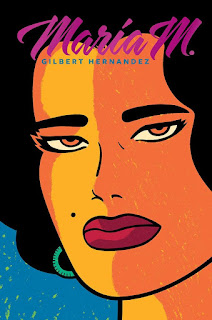The Man in the McIntosh Suit by Rina Ayuyang
The publisher describes this graphic novel as a thriller, but I’d put it solidly in noir – that may seem needlessly nitpicky, but if you’re the kind of reader who has strong opinions on the location of the border between mystery and thriller, it may be helpful.
It’s written and drawn by Rina Ayuyang in a soft, mostly blue palette – I am not an expert on art or tools, but it looks like some kind of art crayon or soft pencil to me, with lots of texture and shades of a few colors but relatively muted lines drawn with a quick, energetic hand.
It’s 1929, somewhere in an agricultural field in Northern California. There’s a group of fruit pickers, who seem to be all Filipino. They aren’t exactly mistreated directly, but the larger white society is prejudiced against them, worker protections are scanty to begin with, and these guys do the poorest-paid, lowest-skill work: it’s a hard life. They all, we think, came here to the US to make money to send back home, either intending to return once they made “enough” or to bring more family members over, one by one, to make a new life in the USA.
The story starts centered on three of the workers, but one quickly becomes central: Alessandro “Bobot” Juaňez, trained as a lawyer in the Philippines and married to Elysia, who he hasn’t seen since he emigrated and hasn’t heard from in longer than he’s happy about. (The other two workers are Angel and Edison; they’re not unimportant, but Bobot is our viewpoint character.)
Bobot is mercurial, with a strong sense of justice and a tendency to do things when they come into his head rather than thinking them through. He’s clearly smart, but doesn’t always let his smarts guide him. His life hasn’t gone the way he hoped it would, but he seems to still be looking forward, planning a better life in California. But he wishes he would hear from Elysia: it’s not clear if he even knows whether she’s in the Philippines or America.
Bobot gets a delayed letter from his cousin, Benny, saying Elysia is in San Francisco; he steals Angel’s fancy suit – this gives the book its title, The Man in the McIntosh Suit , though the suit itself isn’t as important as the weight that title seems to give it – and heads out to find her.
And that’s where it gets noir – or more so, since “migrant workers looking for better lives among prejudiced locals” can already be pretty noir, and there were hints of that plot in the first pages – as Bobot looks for Benny, and gets caught up in the local Filippino community in SF. He gets a job in a small restaurant, alongside Danilo and Dulce, who know Benny – he’s away on some sort of trip, vaguely explained, when Bobot arrives.
He sees the woman Benny wrote him about: La Estrella, the star of the late-night Baranguay Club (probably a speakeasy of some kind, illegal in at least one way), the center of the nightlife of the Filipino ghetto. His impulses get the better of him, and he runs afoul of Renato, who runs the Baranguay and, as he says, pretty much all of the Filipino community in SF.
Bobot wants to get La Estrella away from the Club, and she’s…not uninterested in him. But it’s more complicated than it seems, and Renato might either just swat Bobot down or have work for him to do. And some other players have aims that are not entirely aligned with Bobot’s – for instance, who did send that letter, and why?
All that adds up to noir: people living tough lives, with tough choices, random violence, and outbursts of anger. Men and women in relationships sometimes hidden, sometimes not what they seem. People not who they seem, hiding or mistaken for others. All of them looking for more, for better, and willing to go to extremes for it. And, above all, people making bad choices: that’s the core of noir.
Bobot makes it out at the end of this book; the very last pages imply he will return again. Ayuyang is not done telling the story of this 1929. But McIntosh Suit tells a full story: it stands on its own. It’s a deep dive into a murky world, focused on that essential noir hero, the man who can’t stop himself from his impulses and keeps getting dragged deeper into problems.
Reposted from The Antick Musings of G.B.H. Hornswoggler, Gent.











































